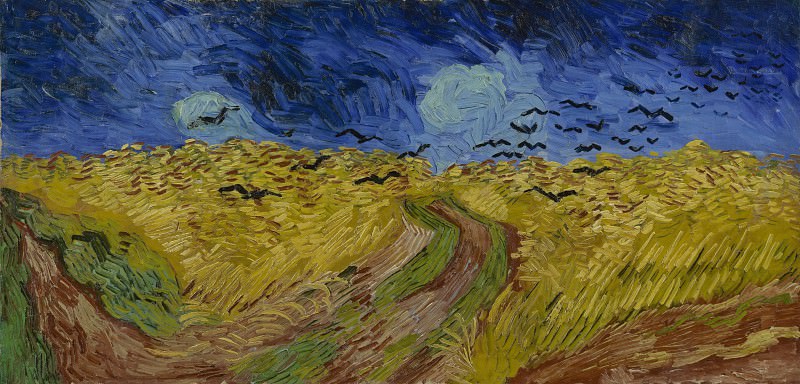Wheat Field Under Threatening Skies Vincent van Gogh (1853-1890)
Vincent van Gogh – Wheat Field Under Threatening Skies
Edit attribution
Download full size: 5200×2491 px (5,0 Mb)
Painter: Vincent van Gogh
Location: Van Gogh Museum, Amsterdam.
Van Gogh, a little more than two weeks before he took his life with a revolver, painted Ravens in a Wheat Field. The painting was executed in July 1890. This work of painting became the artist’s last painted painting, although many researchers disagree. Vincent left his life so tragically through unresolved family and financial problems. It was in this painting that the artist expressed his distraught soul and anxious state.
Description of Vincent van Gogh’s painting Ravens in a Wheat Field
Van Gogh, a little more than two weeks before he took his life with a revolver, painted Ravens in a Wheat Field. The painting was executed in July 1890. This work of painting became the artist’s last painted painting, although many researchers disagree. Vincent left his life so tragically through unresolved family and financial problems. It was in this painting that the artist expressed his distraught soul and anxious state. Even the support of his brother could not help Van Gogh to keep himself alive. In all his years of study and work, he was unfortunately unable to sell his work in any way.
In the painting Ravens in a Wheat Field, the author focuses the viewer’s attention on three paths that diverge in different directions. An agitated gloomy sky merges into one with the earth and creates chaos that the viewer does not understand. To this composition, the author has transferred his sense of unease and boundless loneliness. In the landscape, there seems to be no perspective center. The sharp contrast of the bright yellow field and the dark sky, with ominous black crows, testifies to the artist’s sense of longing and indecision.
Particular importance must be given to the line of the horizon, which clearly divides the entire space into parts, because it is in no way just a part of the composition, because it skillfully shows the artist’s emotions. It is very difficult for the viewer to understand where the horizon ends and where the trails lead. There is no standard author’s rhythm here, no different swirls, just very hard and firm strokes of the artist. When you try to look closely into the canvas, you can feel and understand the author, his loneliness and sadness.
Vincent said: "By creating these paintings, I try to express my sadness and incredible loneliness" Van Gogh, after the tragic end of the artist’s journey, left not a small legacy, which is represented in many genres and reflects different aspects of the human soul, harmony with nature and his life.
Кому понравилось
Пожалуйста, подождите
На эту операцию может потребоваться несколько секунд.
Информация появится в новом окне,
если открытие новых окон не запрещено в настройках вашего браузера.
You need to login
Для работы с коллекциями – пожалуйста, войдите в аккаунт (open in new window).




















You cannot comment Why?
The painting depicts a vast wheat field under a turbulent, dark blue sky. The wheat stalks are rendered with thick, impasto brushstrokes in shades of yellow and gold, creating a sense of movement and texture. A winding path, in earthy tones of brown and green, cuts through the field, leading the viewers eye into the distance.
The sky is dramatic, with swirling patterns of dark blue and lighter patches that suggest heavy, possibly stormy, clouds. A flock of black birds is scattered across the sky and above the wheat field, some flying in formation, others appearing more scattered. There are two areas of lighter, cloud-like forms in the sky, one of which might be interpreted as a distant moon or a particularly bright cloud formation.
The subtexts of this painting are often interpreted through the lens of Vincent van Goghs emotional state at the time of its creation.